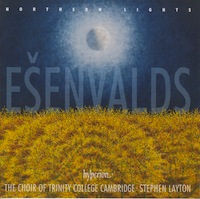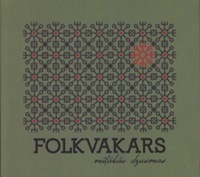Latvian composer Ēriks Ešenvalds has not only become one of the most celebrated composers in Latvia, but his works are reaching and touching audiences all over the world. Particularly his choir music – his pieces have been performed by choirs not just in Europe, but North America, Africa, Australia, and many other places in the world. In recognition of the world wide resonance of Ešenvalds’ choir music, the British music label Hyperion has released a collection of his choir works entitled Northern Lights, featuring the Choir of Trinity College Cambridge, conducted by Stephen Layton.
Though Ešenvalds has composed in many different music genres, achieving success in symphonic music, chamber music, works for solo instruments, among other genres, it is his choir music that has had the most far-reaching success. Perhaps that is due to his own lengthy tenure in the State Choir Latvija, who premiered many of his works. Or perhaps simply due to choir music being arguably the most popular type of academic music in Latvia – composers have many choirs and opportunities to display their talents in Latvia, for example at the Song Festivals.
It is no random event that the Choir of Trinity College is performing these works – as one of Ešenvalds’ many accolades, he held the title of ‘Fellow Commoner’ from 2011 to 2013 at Trinity College, a position that allows the holder to make a contribution to both education as well as work with artists who are just beginning their careers.
Northern Lights is a collection of various choir music styles – mostly sacred works, but also some secular works, the majority of which have been composed specifically for British or American choirs. As with the album At the Foot of the Sky (also a collection of Ešenvalds’ choir music), released in 2013 by the State Choir Latvija, many of the themes of the works relate to heavenly bodies and phenomena, revealing Ešenvalds’ interest in nature and man’s place in the universe.
One of Ešenvalds’ most popular works is ‘O Salutaris Hostia’ – the Trinity Choir is at least the fourth choir to record this piece (other recordings include the Riga Cathedral Girls’ Choir, the Youth Choir Kamēr… and the women’s choir Balta). This comes as no surprise, as the meditative work, featuring the melodic duet of two sopranos, on this recording performed by Rachel Ambrose Evans and Hannah Partridge, evokes a calming prayer, resulting in a kind of spiritual transcendence.
Ešenvalds has found much success in adapting the poetry of American poet Sara Teasdale. Northern Lights features three such works. The first is ‘The New Moon’, which begins as a harsh, seemingly hopeless lament about the difficulties of the day, then evolves into a mystically serene, more positive reflection when the author sees the new moon, giving hope and comfort. Much like ‘The New Moon’, the second Teasdale work ‘Stars’ also features the haunting sound of tuned wine glasses. ‘Stars’ again features the theme of gazing at the heavens, with the resulting wonderment of the beauty of the universe. The third and final Teasdale work ‘Only in Sleep’, which closes the album, is a tender, slightly sentimental dream of youth by the author, brought vividly to life by the soprano solo of Rachel Ambrose Evans. Ešenvalds provides an exceptional musical setting to the melancholic and expressive poetry, instinctively providing both melodic and dissonant music.
The harp of Sally Price adds an additional dimension to three works – ‘Trinity Te Deum’, ‘The Earthly Rose’, and ‘Who Can Sail Without the Wind?’. The harp is used to achieve a particularly dreamy effect in ‘Who Can Sail’, an arrangement of the Swedish folk song ‘Vem kan segla förutan vind?’, an emotional and reflective work about how it can be possible to sail without wind, but it is not possible to leave a friend without shedding tears.
The CD booklet also includes an extensive essay on Ešenvalds and his works written by British composer Gabriel Jackson – a composer who also has close ties to Latvia, as Hyperion released a CD of his works performed by the State Choir Latvija entitled A Ship with Unfurled Sails in 2013. In fact, the Hyperion label has been very supportive of Baltic composers and artists, as they have previously released a collection of Ešenvalds’ choir works – Passion and Resurrection in 2010, as well as a collection of Baltic composers’ choir works entitled Baltic Exchange in 2010, which featured works by Uģis Prauliņš and Maija Einfelde.
Ešenvalds’ next major project is a multimedia symphony based on the Aurora borealis, where he, along with filmmakers, went on expeditions to Iceland, Greenland, Scandinavia and Alaska to gather folklore materials on the Northern Lights. This work will have its premiere on April 27, 2015 at the Latvian National Opera.
Ēriks Ešenvalds once again confirms that his worldwide success is no accident – building further on his reputation of being a versatile composer, particularly in the field of choir music, Northern Lights reaffirms his place among other distinguished contemporary composers. Ešenvalds’ music continues to enthrall both performers and audiences alike, and there is no reason why his reputation should not grow and expand with the release of Northern Lights, which will hopefully deservedly make his music known to even more listeners worldwide. Conductor Stephen Layton, along with the Choir of Trinity College Cambridge, should be commended not just for this excellent performance, but also for raising the profile of the composer, whose ability to write music that deeply affects listeners not just in Latvia, all over the world is a rare talent.
For further information, please visit the composer’s website at www.eriksesenvalds.com and the Hyperion website at www.hyperion-records.co.uk
Details
Northern Lights
Ēriks Ešenvalds
Produced by Adrian Peacock, 2015
Track listing
- O Salutaris Hostia
- The New Moon
- Psalm 67
- Trinity Te Deum
- Northern Lights
- The Heavens’ Flock
- The Earthly Rose
- Merton College Service – Magnificat
- Merton College Service – Nunc dimittis
- Rivers of Light
- Ubi Caritas
- Amazing Grace
- O Emmanuel
- Who Can Sail Without the Wind?
- Stars
- Only in Sleep





